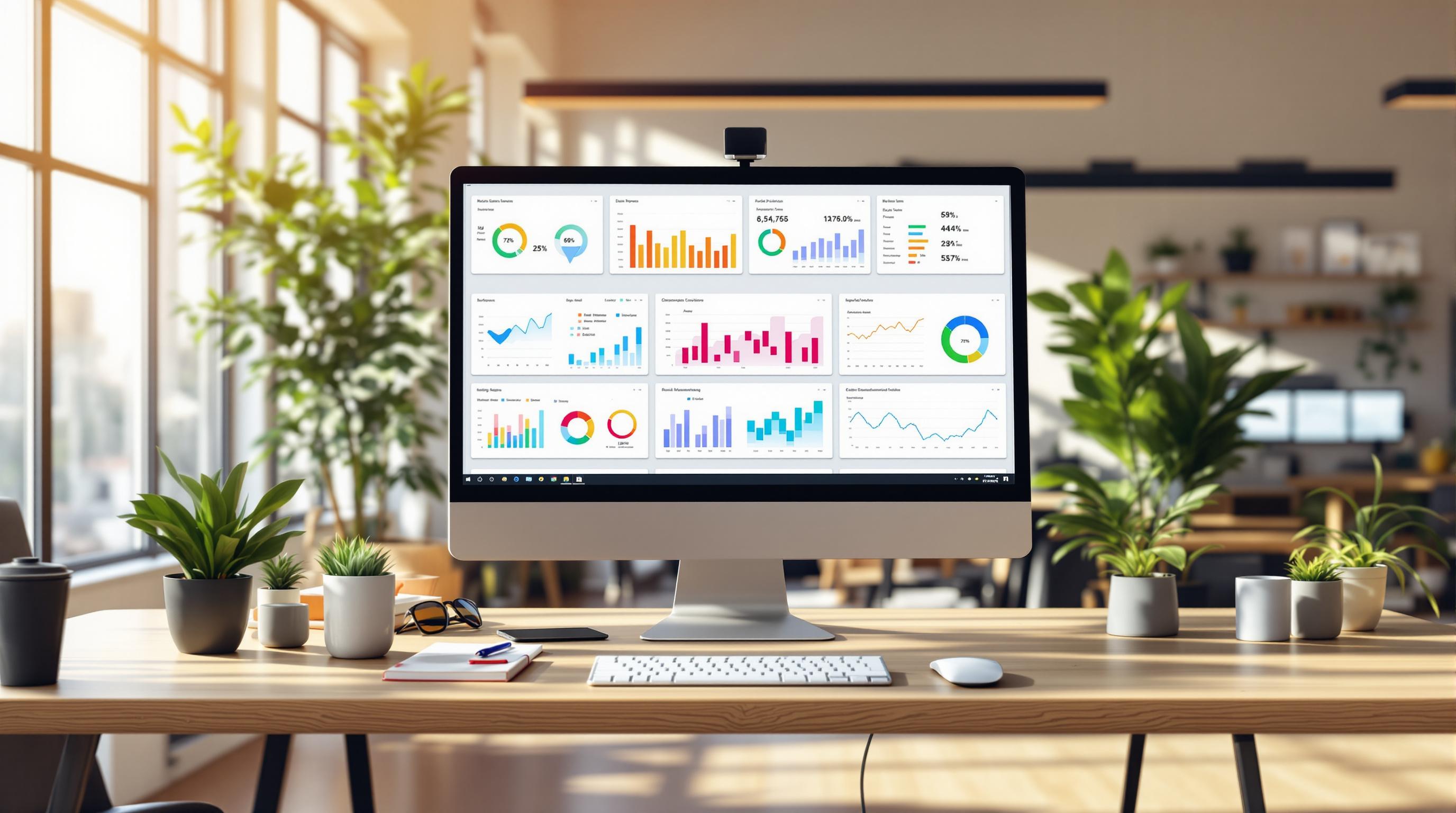Real-time billing analytics helps CFOs make faster, data-driven decisions by providing instant insights into revenue, cash flow, and customer behavior. This guide explains why it matters, key metrics to track, and how to set up a secure and integrated analytics system.
Key Takeaways:
- What It Is: Real-time updates on revenue, payments, and billing patterns for immediate decision-making.
- Why It Matters: Reduces data delays, improves forecasting, and prevents revenue loss.
- Core Metrics: Track Monthly Recurring Revenue (MRR), Days Sales Outstanding (DSO), Customer Lifetime Value (CLV), and more.
- Setup Steps: Choose software with real-time processing, integrate financial systems, and ensure data security.
- Actionable Insights: Use live data to optimize pricing, improve cash flow, and address churn risks early.
By implementing real-time billing analytics, CFOs can enhance financial planning, reduce errors, and protect revenue streams effectively.
Analytics: How Upflow's AR Analytics Dashboards Help Control Accounts Receivable

Core Billing Metrics for CFOs
Real-time billing analytics provides key insights for financial decision-making. Here are the metrics every CFO should focus on.
Revenue Tracking and Prediction
Keep an eye on these critical revenue metrics:
- Monthly Recurring Revenue (MRR): Tracks subscription-based income as it happens.
- Average Revenue Per User (ARPU): Measures trends in customer value over time.
- Revenue Recognition Rate: Ensures compliance with accounting standards.
- Sales Pipeline Velocity: Helps predict future revenue based on the progression of deals.
A well-designed dashboard with clear visuals and automated alerts can help you respond quickly and improve forecasting accuracy. Once revenue is under control, turn your focus to cash flow.
Cash Flow Monitoring
Healthy cash flow is the backbone of financial stability. Pay attention to these indicators:
| Metric | What It Measures | Why It Matters |
|---|---|---|
| Days Sales Outstanding (DSO) | Average time to collect payments | Reflects how efficiently payments are collected. |
| Working Capital Ratio | Current assets vs. liabilities | Indicates short-term financial health. |
| Cash Conversion Cycle | Time to turn resources into cash | Highlights operational efficiency. |
| Payment Success Rate | Successful vs. failed transactions | Flags potential collection problems. |
Real-time tracking of these metrics helps avoid cash flow gaps and ensures working capital stays at optimal levels. Next, dive into customer data to safeguard your revenue streams.
Customer Retention Analysis
Billing data can reveal risks to revenue stability.
Churn Signals to Watch:
- Late payments
- Declining usage
- Requests to downgrade services
- Frequent support tickets
Key Retention Metrics:
- Customer Lifetime Value (CLV): Projects the total revenue from a customer.
- Net Revenue Retention (NRR): Measures revenue growth from existing customers.
- Expansion Revenue Rate: Tracks additional revenue from upsells or cross-sells.
- Renewal Rate: Indicates how often customers renew their subscriptions.
Spotting at-risk customers early is crucial. For instance, a customer who consistently pays late or reduces usage may be on the verge of leaving. By setting baseline metrics and alerts for unusual activity, finance teams can act quickly with targeted strategies to retain customers before cancellations occur.
Setting Up Billing Analytics
To effectively manage your billing metrics, set up an analytics system that ensures ongoing financial transparency.
Choosing Analytics Software
Select billing analytics software that offers clear financial insights and integrates smoothly with your existing tools.
| Feature Category | Must-Have Capabilities | Business Impact |
|---|---|---|
| Real-time Processing | Instant data updates | Enables quick decision-making |
| Integration Options | API support, built-in plugins | Ensures smooth system interactions |
| Reporting Tools | Custom dashboards, automated reporting | Simplifies data interpretation |
| Security Features | Encryption, role-based access | Safeguards sensitive information |
| Scalability | Cloud-based solutions | Adapts to business growth |
Connecting Financial Systems
Linking your financial systems requires a thoughtful process. Here’s how to do it:
1. System Assessment
Analyze your current financial tools, such as ERP systems, accounting software, and payment processors. Map out data flows and pinpoint integration opportunities.
2. Data Mapping
Develop a detailed data dictionary to align fields across systems. This step ensures smooth data transfers and preserves accuracy.
3. Testing Protocol
Adopt a phased testing method:
- Start with migrating historical data
- Progress to real-time data synchronization
- Verify data accuracy across all systems
- Monitor system performance for any issues
Once your systems are fully integrated, focus on securing them to finalize your analytics setup.
Security and Compliance
Protect your financial data using a multi-layered security strategy. This includes encryption, multi-factor authentication, regular audits, and automated backups stored in multiple locations. Adhere to industry standards like SOC 2 Type II, PCI DSS, GDPR, CCPA, and specific regulations such as HIPAA and FINRA.
Key Security Measures:
- Encrypt data both in transit and at rest
- Implement multi-factor authentication for access
- Conduct regular security audits and penetration tests
- Use automated backups with geographically diverse storage
Compliance Standards:
- SOC 2 Type II certification for service providers
- PCI DSS for secure payment processing
- GDPR and CCPA for data privacy
- Industry-specific rules like HIPAA and FINRA
Regularly review your security protocols and keep detailed audit logs for inspections. Consistently train your team on best practices to minimize risks and maintain compliance.
sbb-itb-01010c0
Making Decisions with Live Data
With an integrated system in place, CFOs can use live data to make informed decisions that drive better outcomes.
Price Optimization
Real-time billing analytics gives CFOs the tools to adjust pricing based on up-to-the-minute data. By analyzing transaction trends, customer behavior, and market conditions, pricing can be dynamically fine-tuned.
Key areas to focus on include:
- Tier Analysis: Understand usage patterns across pricing tiers to identify upsell opportunities or prevent churn.
- Competitive Positioning: Compare conversion rates and customer acquisition costs at various price points.
- Value-Based Pricing: Use feature usage data to ensure pricing reflects the actual value customers receive.
These strategies not only refine pricing but also improve financial forecasting accuracy.
Better Financial Forecasts
Real-time analytics enhances forecasting by offering immediate insights into revenue trends and customer behaviors. Here's how it improves traditional forecasting methods:
| Forecast Component | Traditional Method | Real-Time Analytics Advantage |
|---|---|---|
| Revenue Prediction | Relies on monthly historical data | Uses hourly usage trends for precision |
| Cash Flow Planning | Based on quarterly estimates | Provides daily cash position updates |
| Customer Churn | Uses annual averages | Offers immediate risk indicators |
| Market Changes | Reacts slowly to shifts | Adapts quickly with live data |
This level of accuracy also highlights areas where revenue might be slipping through the cracks.
Stopping Revenue Loss
Preventing revenue loss requires constant monitoring and quick action. Real-time billing analytics helps CFOs identify and address common problem areas:
1. Usage Monitoring
Keep an eye on service usage patterns to detect unusual changes that might signal billing errors or customer dissatisfaction. Automated alerts can flag significant deviations.
2. Payment Processing
Identify failed payments and billing errors in real time to avoid cash flow interruptions. Use automated retry systems and customer communication workflows to resolve issues quickly.
3. Subscription Management
Track key subscription metrics such as:
- Renewal rates
- Upgrade or downgrade trends
- Usage compared to entitlements
- Payment timing
These insights help pinpoint and address potential revenue leaks:
| Revenue Loss Point | Detection Method | Mitigation Strategy |
|---|---|---|
| Failed Payments | Real-time monitoring | Automated retry processes |
| Usage Overages | Threshold alerts | Proactive customer notifications |
| Pricing Mismatches | Contract-rate comparisons | Automated pricing enforcement |
| Churn Indicators | Engagement scoring | Early intervention programs |
Common Analytics Obstacles
Real-time data opens up the ability to act quickly, but tackling common analytics challenges is essential for gaining consistent and actionable insights.
Data Accuracy
Getting accurate real-time billing data hinges on having reliable systems and processes. Here are some typical challenges to watch out for:
Integration Issues
- Systems using incompatible data formats
- Delays in syncing data across platforms
- Missing transaction records caused by API errors
Data Validation
To ensure accuracy, set up automated validation checks. Here's a quick guide:
| Validation Type | Purpose | Implementation Method |
|---|---|---|
| Format Verification | Keep data structure consistent | Use automated field checks |
| Cross-System Matching | Confirm data aligns across systems | Real-time reconciliation |
| Historical Comparison | Spot unusual patterns | Apply trend analysis tools |
| Duplicate Detection | Avoid double-counting entries | Track unique identifiers |
Once data accuracy is under control, the next step is making sure your team knows how to effectively use these tools.
Staff Training and Buy-in
For real-time billing analytics to succeed, your team needs to be fully on board. Focus on these key areas:
Technical Proficiency
Train your staff on how to navigate dashboards, export data, and handle alerts effectively.
Change Management
Adopt a structured process to ensure smooth implementation:
-
Initial Assessment
- Analyze current analytics capabilities and pinpoint training needs.
- Document any workflow changes tied to analytics.
-
Phased Implementation
- Start with basic analytics features.
- Gradually introduce advanced metrics and reporting.
-
Continuous Support
- Regularly evaluate team skills and provide follow-up training.
- Offer resources to close any knowledge gaps.
With a well-trained team in place, the next challenge is balancing short-term insights with long-term strategies.
Short vs Long-term Planning
To get the most out of your analytics, find the right balance between immediate actions and strategic goals.
Data Integration Strategy
Here's how to approach data insights over different timeframes:
| Timeframe | Focus Area | Key Metrics |
|---|---|---|
| Daily | Monitor cash flow | Payment processing rates |
| Weekly | Track revenue | Customer acquisition costs |
| Monthly | Analyze trends | Churn rates and customer patterns |
| Quarterly | Plan strategically | Market position indicators |
| Annual | Forecast long-term | Growth trajectory metrics |
Decision Framework
- Use real-time data to make quick operational changes.
- Look at trends over time to guide strategic decisions.
- Define clear thresholds for when immediate action is necessary.
- Schedule regular reviews to align short-term actions with long-term goals.
The trick is staying adaptable while keeping your eye on the bigger picture. Real-time data should support your strategy, not control it.
Industry Resources and Tools
Effective tools can transform billing analytics, offering solutions to many of the challenges CFOs face.
Tools from the B2B Ecosystem
The B2B Ecosystem, through its QuantAIfy brand, provides AI-driven tools designed to support financial leaders:
| Tool Name | Primary Function | Benefits for CFOs |
|---|---|---|
| Price Strategist | Optimizes pricing strategies | Analyzes competitors and tracks conversions in real-time |
| TAM Analyst | Assesses market size | Calculates revenue potential using data insights |
| Risk Analyzer | Scores financial risks | Provides real-time risk assessments based on market data |
| AI Process Optimizer | Automates workflows | Simplifies billing processes and improves efficiency |
For example, Price Strategist enables CFOs to make informed pricing decisions by evaluating market trends and customer behavior. These tools, paired with a broader analytics strategy, can unlock further growth opportunities.
Analytics-Driven Growth
The B2B Ecosystem platform combines advanced tools with expert support to empower financial decision-making. Their offerings include:
- Access to specialized directories for finding analytics solutions
- Consulting services to assist with analytics integration
- Regular industry updates shared through their media channels
- Custom tool development tailored to unique billing needs
Conclusion
Key Benefits
Real-time billing analytics reshapes how CFOs make decisions. It improves revenue tracking, boosts forecasting precision, streamlines cash flow management, and minimizes revenue loss.
Steps to Get Started
To make the most of these tools, consider these steps:
-
Evaluate and Plan
Review your current billing workflows, identify performance metrics that match your financial goals, and set clear targets. -
Choose the Right Tools
Pick analytics software that works well with your existing systems, ensures strong security and compliance, and can grow with your business. -
Build a Skilled Team
Provide focused training, keep thorough documentation, and assign a team to ensure data accuracy and effective use of the tools. -
Test and Refine
Start with a pilot program in one department. Track results, collect feedback, and refine the processes before rolling out across the company. Regularly audit and update systems to maintain efficiency.


